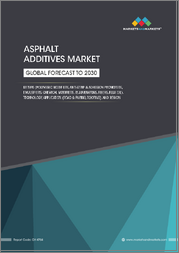
|
시장보고서
상품코드
1743342
아스팔트 첨가제 시장 규모, 점유율, 성장 분석 : 유형별, 기술별, 용도별, 지역별 - 산업 예측(2025-2032년)Asphalt Additives Market Size, Share, and Growth Analysis, By Type (Polymeric Modifiers, Anti-strip & Adhesion Promoters), By Technology (Hot Mix, Cold Mix), By Application, By Region - Industry Forecast 2025-2032 |
||||||
아스팔트 첨가제 세계 시장 규모는 2023년에 40억 달러로 평가되었으며, 예측 기간(2025-2032년) 동안 CAGR 7.7%로 성장하여 2024년 43억 1,000만 달러에서 2032년까지 78억 달러로 성장할 전망입니다.
세계 아스팔트 첨가제 시장은 인프라 개발에 대한 투자 증가와 지속가능한 아스팔트 솔루션에 대한 수요 증가에 의해 크게 견인되고 있습니다. 또한, 지속적인 도로 정비 및 보수 활동은 시장 성장에 중요한 기여를 하고 있습니다. 또한, 아스팔트의 내구성 향상에 대한 관심이 높아지면서 성능과 수명을 향상시키는 혁신적인 첨가제의 채택이 증가하고 있습니다. 이러한 추세는 최적의 도로 안전과 신뢰성을 보장하는 동시에 현대의 환경 기준을 충족하는 고품질 재료를 개발하려는 업계의 노력을 강조하고 있습니다. 이러한 요소들이 결합되어 아스팔트 첨가제 시장은 인프라 및 건설 부문의 진화하는 요구에 부응하는 견고하고 역동적인 시장을 형성하고 있습니다.
목차
소개
- 조사 목적
- 조사 범위
- 정의
조사 방법
- 정보 조달
- 2차와 1차 데이터 방법
- 시장 규모 예측
- 시장 가정과 제한
주요 요약
- 세계 시장 전망
- 공급과 수요 동향 분석
- 부문별 기회 분석
시장 역학과 전망
- 시장 개요
- 시장 규모
- 시장 역학
- 성장 촉진요인과 기회
- 성장 억제요인과 과제
- Porters 분석
주요 시장 인사이트
- 핵심성공요인
- 경쟁 정도
- 주요 투자 기회
- 시장 생태계
- 시장 매력 지수(2024년)
- PESTEL 분석
- 거시경제 지표
- 밸류체인 분석
- 가격 분석
- 규제 상황
- 사례 연구
- 고객과 구매 기준 분석
- 원재료 분석
아스팔트 첨가제 시장 규모 : 유형별 & CAGR(2025-2032년)
- 시장 개요
- 폴리머 개질제
- 박리 방지제 및 접착 촉진제
- 유화제
- 화학적 개질제
- 회춘제
- 섬유
- 플럭스 오일
- 착색 아스팔트
- 기타
아스팔트 첨가제 시장 규모 : 기술별 & CAGR(2025-2032년)
- 시장 개요
- 핫 믹스
- 콜드 믹스
- 웜 믹스
아스팔트 첨가제 시장 규모 : 용도별 & CAGR(2025-2032년)
- 시장 개요
- 도로 건설과 포장
- 지붕
- 공항 건설
- 기타
아스팔트 첨가제 시장 규모 & CAGR(2025-2032년)
- 북미
- 미국
- 캐나다
- 유럽
- 독일
- 스페인
- 프랑스
- 영국
- 이탈리아
- 기타 유럽
- 아시아태평양
- 중국
- 인도
- 일본
- 한국
- 기타 아시아태평양
- 라틴아메리카
- 브라질
- 기타 라틴아메리카
- 중동 및 아프리카
- GCC 국가
- 남아프리카공화국
- 기타 중동 및 아프리카
경쟁 정보
- 상위 5개사의 비교
- 주요 기업의 시장 포지셔닝(2024년)
- 주요 시장 기업이 채용한 전략
- 최근의 시장 동향
- 기업의 시장 점유율 분석(2024년)
- 주요 기업 개요
- 기업 상세
- 제품 포트폴리오 분석
- 기업 부문별 점유율 분석
- 매출 전년비 비교(2022-2024년)
주요 기업 개요
- Arkema SA(France)
- BASF SE(Germany)
- Evonik Industries AG(Germany)
- Huntsman Corporation(United States)
- Sasol Limited(South Africa)
- Sinopec Corporation(China)
- Dow Inc.(United States)
- Honeywell International Inc.(United States)
- Kraton Corporation(United States)
- Ingevity Corporation(United States)
- Akzo Nobel N.V.(Netherlands)
- Kao Corporation(Japan)
- Tri-Chem Specialty Chemicals LLC(United States)
- Cargill, Incorporated(United States)
- Iterchimica S.r.l.(Italy)
- Engineered Additives LLC(United States)
- Colorbiotics by Sika AG(Switzerland)
결론과 제안
KSM 25.06.20Global Asphalt Additives Market size was valued at USD 4.0 billion in 2023 and is poised to grow from USD 4.31 billion in 2024 to USD 7.8 billion by 2032, growing at a CAGR of 7.7% during the forecast period (2025-2032).
The global asphalt additives market is significantly driven by increasing investments in infrastructure development and a rising demand for sustainable asphalt solutions. Additionally, the ongoing activities in road maintenance and repair are crucial contributors to market growth. There is also a strong emphasis on enhancing the durability of asphalt, leading to increased adoption of innovative additives that improve performance and longevity. This trend highlights the industry's commitment to developing high-quality materials that meet modern environmental standards while ensuring optimal road safety and reliability. The combination of these factors is fostering a robust and dynamic marketplace for asphalt additives, catering to the evolving needs of infrastructure and construction sectors.
Top-down and bottom-up approaches were used to estimate and validate the size of the Global Asphalt Additives market and to estimate the size of various other dependent submarkets. The research methodology used to estimate the market size includes the following details: The key players in the market were identified through secondary research, and their market shares in the respective regions were determined through primary and secondary research. This entire procedure includes the study of the annual and financial reports of the top market players and extensive interviews for key insights from industry leaders such as CEOs, VPs, directors, and marketing executives. All percentage shares split, and breakdowns were determined using secondary sources and verified through Primary sources. All possible parameters that affect the markets covered in this research study have been accounted for, viewed in extensive detail, verified through primary research, and analyzed to get the final quantitative and qualitative data.
Global Asphalt Additives Market Segments Analysis
Global Asphalt Additives Market is segmented by Type, Technology, Application and region. Based on Type, the market is segmented into Polymeric Modifiers, Anti-strip & Adhesion Promoters, Emulsifiers, Chemical Modifiers, Rejuvenators, Fibers, Flux Oil, Colored Asphalt and Others. Based on Technology, the market is segmented into Hot Mix, Cold Mix and Warm Mix. Based on Application, the market is segmented into Road Construction & Paving, Roofing, Airport Construction and Others. Based on region, the market is segmented into North America, Europe, Asia Pacific, Latin America and Middle East & Africa.
Driver of the Global Asphalt Additives Market
The rising traffic levels and the increasing variability in global climate patterns have significantly boosted the need for highly durable road infrastructure. This has resulted in a heightened demand for polymer additives, including styrene-butadiene-styrene (SBS) and ethylene-vinyl acetate (EVA), which enhance the elasticity of asphalt and improve its resistance to rutting and cracking in extreme weather conditions. Key regions poised for growth in the asphalt additives market include Canada, Russia, and the Middle East, positioning them as critical areas for suppliers looking to capitalize on this robust demand in the coming years.
Restraints in the Global Asphalt Additives Market
The Global Asphalt Additives market faces significant challenges due to its reliance on the availability and cost of raw materials. Key components such as polymers, waxes, and chemicals sourced from petroleum and natural origins are integral to the production of asphalt additives. However, the fluctuating prices of these materials can lead to a downturn in global demand, affecting overall market growth. Furthermore, this price instability poses a threat to the profitability of manufacturers, making it difficult for companies to maintain consistent operations and financial performance in the long term. As a result, the market may experience restrained progress in the future.
Market Trends of the Global Asphalt Additives Market
The Global Asphalt Additives market is increasingly influenced by the adoption of recycled asphalt and circular economy initiatives, reflecting a significant shift towards sustainability. As governments and construction firms prioritize eco-friendly practices, the demand for rejuvenators and bio-based additives is on the rise, facilitating the restoration of aged asphalt and enhancing overall performance. This trend not only reduces waste but also minimizes raw material consumption, positioning sustainable practices as crucial for the industry's long-term viability. Consequently, asphalt additive companies that align with these advancements in sustainability are likely to gain a competitive edge, thereby shaping the future landscape of the market.
Table of Contents
Introduction
- Objectives of the Study
- Scope of the Report
- Definitions
Research Methodology
- Information Procurement
- Secondary & Primary Data Methods
- Market Size Estimation
- Market Assumptions & Limitations
Executive Summary
- Global Market Outlook
- Supply & Demand Trend Analysis
- Segmental Opportunity Analysis
Market Dynamics & Outlook
- Market Overview
- Market Size
- Market Dynamics
- Drivers & Opportunities
- Restraints & Challenges
- Porters Analysis
- Competitive rivalry
- Threat of substitute
- Bargaining power of buyers
- Threat of new entrants
- Bargaining power of suppliers
Key Market Insights
- Key Success Factors
- Degree of Competition
- Top Investment Pockets
- Market Ecosystem
- Market Attractiveness Index, 2024
- PESTEL Analysis
- Macro-Economic Indicators
- Value Chain Analysis
- Pricing Analysis
- Regulatory Landscape
- Case Studies
- Customer & Buying Criteria Analysis
- Raw Material Analysis
Global Asphalt Additives Market Size by Type & CAGR (2025-2032)
- Market Overview
- Polymeric Modifiers
- Anti-strip & Adhesion Promoters
- Emulsifiers
- Chemical Modifiers
- Rejuvenators
- Fibers
- Flux Oil
- Colored Asphalt
- Others
Global Asphalt Additives Market Size by Technology & CAGR (2025-2032)
- Market Overview
- Hot Mix
- Cold Mix
- Warm Mix
Global Asphalt Additives Market Size by Application & CAGR (2025-2032)
- Market Overview
- Road Construction & Paving
- Roofing
- Airport Construction
- Others
Global Asphalt Additives Market Size & CAGR (2025-2032)
- North America (Type, Technology, Application)
- US
- Canada
- Europe (Type, Technology, Application)
- Germany
- Spain
- France
- UK
- Italy
- Rest of Europe
- Asia Pacific (Type, Technology, Application)
- China
- India
- Japan
- South Korea
- Rest of Asia-Pacific
- Latin America (Type, Technology, Application)
- Brazil
- Rest of Latin America
- Middle East & Africa (Type, Technology, Application)
- GCC Countries
- South Africa
- Rest of Middle East & Africa
Competitive Intelligence
- Top 5 Player Comparison
- Market Positioning of Key Players, 2024
- Strategies Adopted by Key Market Players
- Recent Developments in the Market
- Company Market Share Analysis, 2024
- Company Profiles of All Key Players
- Company Details
- Product Portfolio Analysis
- Company's Segmental Share Analysis
- Revenue Y-O-Y Comparison (2022-2024)
Key Company Profiles
- Arkema SA (France)
- Company Overview
- Business Segment Overview
- Financial Updates
- Key Developments
- BASF SE (Germany)
- Company Overview
- Business Segment Overview
- Financial Updates
- Key Developments
- Evonik Industries AG (Germany)
- Company Overview
- Business Segment Overview
- Financial Updates
- Key Developments
- Huntsman Corporation (United States)
- Company Overview
- Business Segment Overview
- Financial Updates
- Key Developments
- Sasol Limited (South Africa)
- Company Overview
- Business Segment Overview
- Financial Updates
- Key Developments
- Sinopec Corporation (China)
- Company Overview
- Business Segment Overview
- Financial Updates
- Key Developments
- Dow Inc. (United States)
- Company Overview
- Business Segment Overview
- Financial Updates
- Key Developments
- Honeywell International Inc. (United States)
- Company Overview
- Business Segment Overview
- Financial Updates
- Key Developments
- Kraton Corporation (United States)
- Company Overview
- Business Segment Overview
- Financial Updates
- Key Developments
- Ingevity Corporation (United States)
- Company Overview
- Business Segment Overview
- Financial Updates
- Key Developments
- Akzo Nobel N.V. (Netherlands)
- Company Overview
- Business Segment Overview
- Financial Updates
- Key Developments
- Kao Corporation (Japan)
- Company Overview
- Business Segment Overview
- Financial Updates
- Key Developments
- Tri-Chem Specialty Chemicals LLC (United States)
- Company Overview
- Business Segment Overview
- Financial Updates
- Key Developments
- Cargill, Incorporated (United States)
- Company Overview
- Business Segment Overview
- Financial Updates
- Key Developments
- Iterchimica S.r.l. (Italy)
- Company Overview
- Business Segment Overview
- Financial Updates
- Key Developments
- Engineered Additives LLC (United States)
- Company Overview
- Business Segment Overview
- Financial Updates
- Key Developments
- Colorbiotics by Sika AG (Switzerland)
- Company Overview
- Business Segment Overview
- Financial Updates
- Key Developments



















